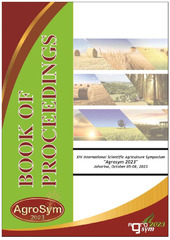Приказ основних података о документу
Response of different wheat genotypes to drought in semi-arid climate conditions
| dc.creator | Zečević, Veselinka | |
| dc.creator | Stojšin, Vojislav | |
| dc.creator | Knežević, Desimir | |
| dc.creator | Matković Stojšin, Mirela | |
| dc.creator | Savić, Slađana | |
| dc.creator | Urošević, Dušan | |
| dc.creator | Mićanović, Danica | |
| dc.date.accessioned | 2023-12-19T07:34:35Z | |
| dc.date.available | 2023-12-19T07:34:35Z | |
| dc.date.issued | 2023 | |
| dc.identifier.isbn | 978-99976-816-1-4 | |
| dc.identifier.uri | http://RIVeC.institut-palanka.rs/handle/123456789/808 | |
| dc.description.abstract | A two-year study was conducted on 16 wheat genotypes with the aim of examining the reaction of genotypes to different environmental conditions. Grain weight per spike is a quantitative trait, which phenotypic expression is determined by the influence of a number of minor genes and environmental factors. Therefore, this trait is a suitable phenotypic marker of influence of environmental factors on the plant. The year factor had the largest share in the variation of grain weight per spike (67.82%), while the share of the genotype and the genotype x year interaction was significantly smaller (14.98 and 10.95% respectively). Drought conditions, which characterized the 2016/2017 growing season, affected the reduction of grain weight per spike by 41.7%. The greatest reduction in the value of trait under stress conditions was recorded in Fundulea 4 genotype (63.14%), which achieved the highest value in favorable environmental conditions (3.5 g), while in drought conditions it had a below-average value (1.29 g). Also, Dunavka genotype made good use of favorable environmental conditions to achieve a high value of grain weight per spike (3.14 g), so it can be recommended for breeding in favorable climatic conditions. On the other hand, the highest tolerance to drought was exhibited by the Pitoma genotype, which recorded a 15.67% decrease in grain weight per spike. The high tolerance of the mentioned genotype results from the highest value of the trait achieved in the dry growing season (1.83 g), which makes this genotype a good genetic resource for breeding for drought tolerance. | sr |
| dc.language.iso | en | sr |
| dc.publisher | East Sarajevo : Faculty of Agriculture | sr |
| dc.relation | info:eu-repo/grantAgreement/MESTD/inst-2020/200216/RS// | sr |
| dc.relation | info:eu-repo/grantAgreement/MESTD/inst-2020/200054/RS// | sr |
| dc.relation | info:eu-repo/grantAgreement/MESTD/inst-2020/200010RS// | sr |
| dc.rights | openAccess | sr |
| dc.source | Book of proceedings : XIV International Scientific Agriculture Symposium "AGROSYM 2023", Jahorina, 2023 October 05 - 08 | sr |
| dc.subject | wheat | sr |
| dc.subject | drought stress | sr |
| dc.subject | tolerance | sr |
| dc.subject | genetic resources | sr |
| dc.title | Response of different wheat genotypes to drought in semi-arid climate conditions | sr |
| dc.type | conferenceObject | sr |
| dc.rights.license | ARR | sr |
| dc.citation.epage | 364 | |
| dc.citation.spage | 359 | |
| dc.identifier.fulltext | http://RIVeC.institut-palanka.rs/bitstream/id/2598/bitstream_2598.pdf | |
| dc.identifier.rcub | https://hdl.handle.net/21.15107/rcub_rivec_808 | |
| dc.type.version | publishedVersion | sr |


